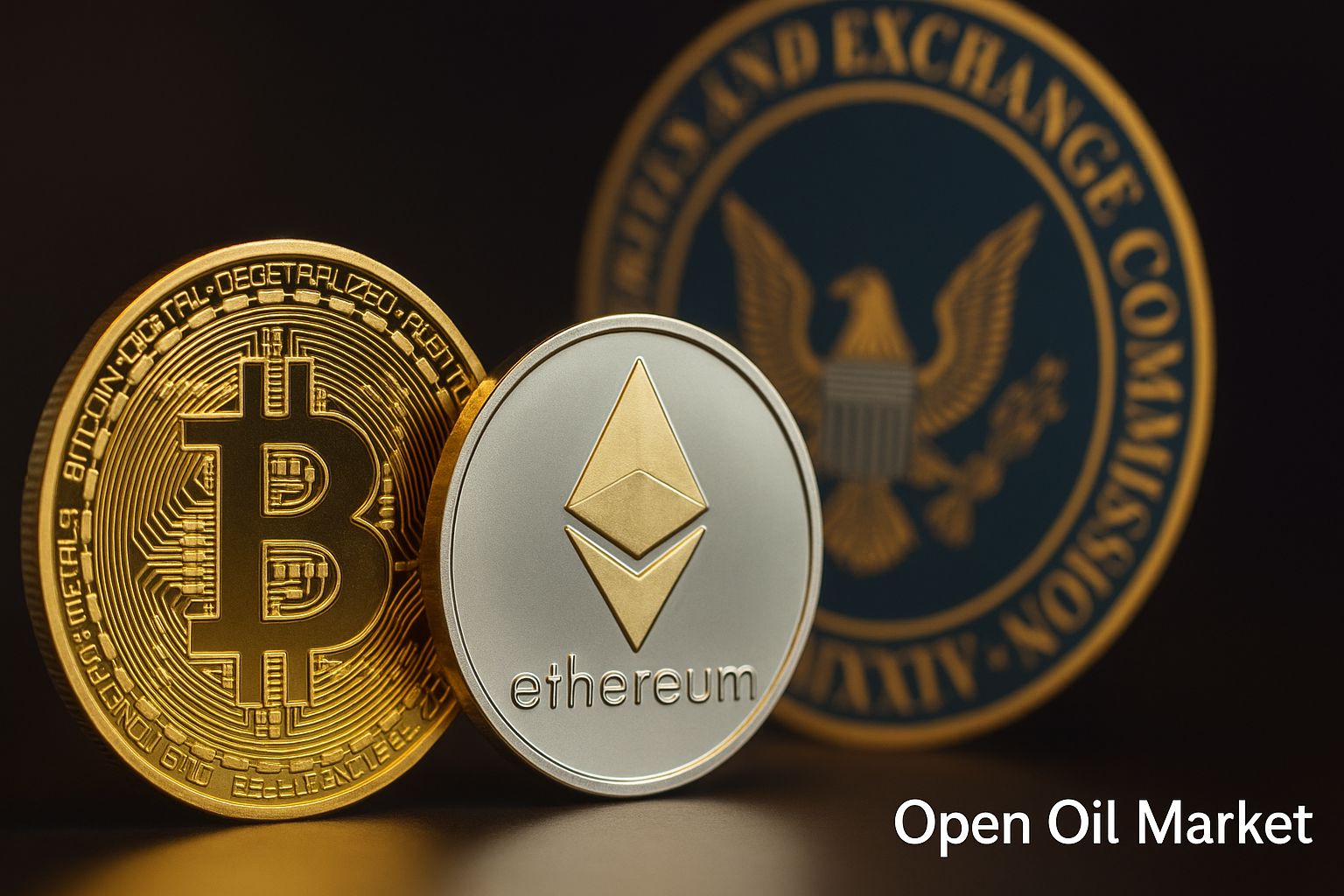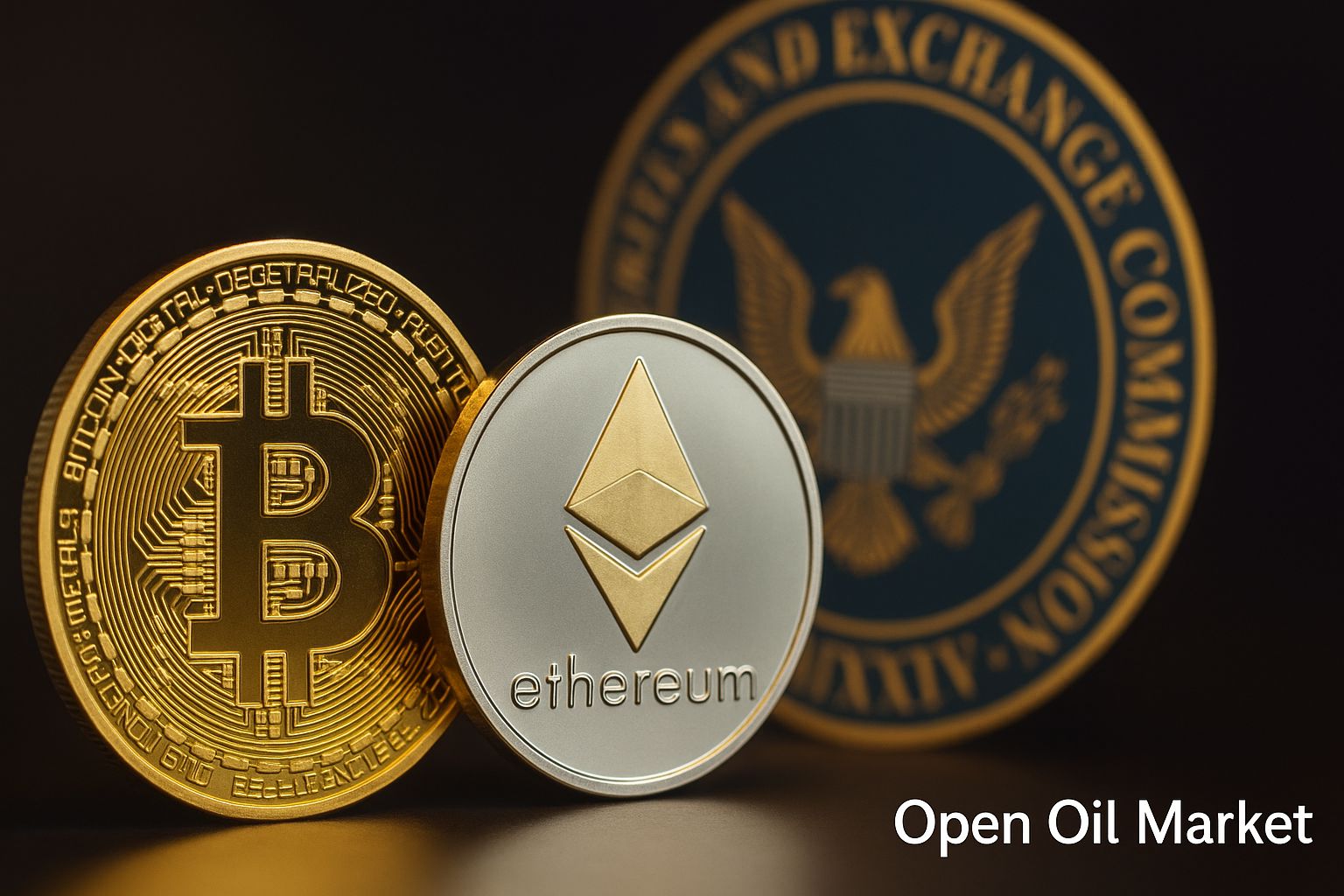
Cryptocurrency News, Tuesday, August 5, 2025 — Crypto Market Consolidates; SEC Unveils Revolutionary Crypto Initiative
As of Tuesday morning, August 5, 2025, the cryptocurrency market is showing a phase of consolidation at elevated levels following a tumultuous rally and subsequent correction. The overall market capitalization of digital assets remains around record values (approximately $3.7–3.8 trillion), having only slightly retreated from recent peaks. Volatility remains moderate: after profit-taking at the end of last week, prices stabilized, with no sharp price jumps observed. The Crypto Fear & Greed Index still resides in the "greed" zone (averaging the 60s out of 100), reflecting the sustained optimism of participants, albeit slightly diminished from extreme levels. Investors are assessing the new informational backdrop and preparing for further market movements.
Crypto Market: Consolidation at High Levels
Following the rapid growth in July, the market transitioned into a state of **consolidation** at the beginning of August. Many leading coins have pulled back from historical highs by several percentage points, largely due to natural profit-taking by major holders at these heights. For instance, over the weekend, the flagship Bitcoin saw a decline of approximately 7% from peak values, dropping to a local minimum of around $112,000, but quickly regained its footing. By the beginning of the new week, most of the lost levels were recovered, and the market is now balancing in a narrow range. Analysts view this pause as a healthy "digestion" of the previous rally, with investors weighing further steps and awaiting new growth drivers. The external macroeconomic backdrop remains relatively neutral: the U.S. Federal Reserve, at its July meeting, predictably kept rates unchanged, avoiding negative surprises, although upcoming inflation data and the annual Fed symposium in Jackson Hole could temporarily increase volatility. Overall, the sentiment in the crypto market remains cautiously positive: despite the recent minor correction, investor confidence in the market and interest in digital assets remain high.
Bitcoin: Consolidation Below Record High
The largest cryptocurrency, Bitcoin (BTC), continues to hover near its historical record after recent fluctuations. Last week, BTC set a new high of around $125,000, surpassing its previous peak, but then the "bulls" encountered resistance: at psychologically significant levels above $120,000, several large investors began taking profits. This triggered a local pullback — by the end of the week, the price had dropped to approximately $112,000, marking a low not seen in the last three weeks. Nevertheless, the downward movement proved short-term: buyers quickly stepped in to buy the dip, and Bitcoin is now consolidating just below the peak, trading around $115,000. Sustained investor interest is evidenced by the fact that whenever prices dip, new buy orders appear — major players and funds use pullbacks to build their positions. The fundamental factors for 2025 remain in BTC's favor: limited coin supply following the 2024 halving and a robust influx of institutional capital (including through promising crypto spot ETFs) continue to support the long-term upward trend. A number of analysts predict that under favorable conditions, Bitcoin may reach new heights by the year's end — optimistic scenarios place targets in the $150,000–180,000 range (with the boldest estimates reaching $200,000). Of course, volatility remains high, and any significant economic or geopolitical upheavals could trigger price corrections. However, overall, the fundamental backdrop is positive: institutional investors view BTC as the digital equivalent of gold, and many retail traders continue to adhere to the "buy the dip" strategy, expecting further long-term growth.
Ethereum and Altcoins: Strengthening Positions
The second-largest crypto asset, Ethereum (ETH), demonstrates confident dynamics and maintains an upward trend alongside other leading altcoins. In July, Ether rose by over 50%, surpassing the $3,500 mark for the first time in several years. By the end of the month, ETH was closely approaching the psychological level of $4,000, and although it has not yet managed to establish itself above this threshold due to selling resistance around $3,900, the overall sentiment surrounding ETH remains optimistic. The course of Ethereum benefits from the successes of the decentralized finance (DeFi) ecosystem and the ongoing popularity of NFTs, as well as regular technical updates to the network that enhance its scalability and efficiency. Institutional interest is also on Ethereum's side: record volumes have been attracted to investment products based on ETH (funds and ETFs), indicating strong trust in the smart contract platform from major players.
Among the altcoins, XRP and BNB stand out, continuing to strengthen their positions. XRP — the native token of the Ripple payment network — hovers around multi-year highs (approximately $3) following Ripple's sensational legal victory over the SEC, which provided much-needed regulatory clarity for the token. Additional momentum for interest in XRP stems from expectations for the launch of exchange-traded funds on this token: news of a possible imminent approval of an ETF on XRP has sparked investor optimism and helped the coin return to levels not seen since 2018. In turn, Binance Coin (BNB), the internal cryptocurrency of the largest crypto exchange Binance and its blockchain ecosystem, trades at over year-long highs (near $800). Despite past challenges related to regulatory pressure on Binance, the BNB token has not only recovered but reached an all-time high amid the expansion of the exchange's services and growth in its user base. Other major altcoins also exhibit positive dynamics. The Cardano (ADA) platform is gradually growing as its highly scientific blockchain ecosystem develops (the use of the Proof-of-Stake algorithm and formal design methods attracts developers and investors), although the ADA price is still notably below historical highs. Solana (SOL), after a downturn in 2022, has regained attention due to its high transaction speed and scalability — SOL has returned to the top ten and strengthened its position after overcoming the consequences of past technical issues. Overall, the altcoin segment remains active: capital is gradually flowing into alternative coins, especially those with clear technological advantages or community backing.
Top 10 Most Popular Cryptocurrencies
Despite the existence of thousands of different digital coins, investor attention is primarily focused on a few major assets. Below is the current list of the **top 10 cryptocurrencies by market capitalization** as of today:
- Bitcoin (BTC) — the first and largest cryptocurrency, often referred to as "digital gold." BTC remains the main benchmark for the entire crypto market and recently set a new price record, reinforcing its status as a reliable asset in the eyes of institutional and retail investors.
- Ethereum (ETH) — the second-largest crypto asset and leading smart contract platform. Ethereum underpins most decentralized applications (DeFi) and the NFT ecosystem. With the development of its network (transition to PoS, improved scalability) and broad community support, ETH continues to strengthen its market position.
- XRP (XRP) — the Ripple payment network token for fast international transfers. XRP has significantly increased in value amid positive regulatory changes and Ripple's victory in its lawsuit against the SEC, which restored the token's status as one of the most significant cryptocurrencies. XRP is currently trading at levels not seen since 2018, confirming increased investor interest.
- Tether (USDT) — the largest stablecoin pegged to the US dollar at a 1:1 ratio. USDT is widely used by traders and investors to preserve capital during high market volatility, as well as being a primary liquidity tool in cryptocurrency trading. Its stability and widespread acceptance make USDT a key element of the crypto economy.
- Binance Coin (BNB) — the internal cryptocurrency of the Binance exchange and its blockchain ecosystem (BNB Chain). BNB is used to pay trading fees, participate in token sales, and in various DeFi services on the Binance platform. The coin has risen significantly in value along with the expansion of the Binance ecosystem and maintains strong positions due to the exchange's massive user base.
- USD Coin (USDC) — a popular dollar-pegged stablecoin issued by Circle and Coinbase. USDC is known for its transparent reserves and regular auditing, as well as support from US regulatory authorities, enhancing its trustworthiness among market participants. USDC is actively used in trading, DeFi protocols, and international settlements as a reliable digital dollar.
- Cardano (ADA) — a cryptocurrency and blockchain platform evolving with a scientific approach (using validated research and formal development methods). ADA consistently ranks among the top ten largest assets, attracting attention from smart contract developers and long-term investors. Although the ADA price is still lower than its record levels from the previous cycle, ongoing technical development of the project supports optimistic expectations.
- Dogecoin (DOGE) — the well-known "meme cryptocurrency," initially created as a joke. Despite its unserious origins, DOGE remains one of the largest digital assets by market capitalization thanks to its active community and support from well-known entrepreneurs (such as Elon Musk). Dogecoin continues to be in demand as a speculative instrument and a gauge of retail investor sentiment.
- Solana (SOL) — a high-speed blockchain for scalable decentralized applications and financial services. Solana is known for its ability to process thousands of transactions per second with low fees. Having returned to the top ten, SOL has strengthened its position due to technological innovations and regained investor confidence after overcoming past difficulties.
- TRON (TRX) — a platform for smart contracts and decentralized applications, particularly popular in Asian countries. The TRX token remains among market leaders largely due to its widespread use in stablecoin transactions (many USDT transactions occur on the Tron network) and its vast ecosystem of services. The active stance of the Tron team and community support enable TRX to maintain its place among the top ten cryptocurrencies.
Regulation of Cryptocurrencies: Global Progress
The regulatory environment surrounding digital assets continues to evolve significantly worldwide, becoming increasingly favorable for the industry. Important measures are being taken across different jurisdictions aimed at integrating cryptocurrencies into the legal framework and reducing uncertainty for market participants:
- USA: American authorities have taken a number of historic steps in regulating the crypto sector. President Donald Trump recently signed the first federal law directly regulating stablecoins (referred to as the GENIUS Act), which requires issuers to maintain 100% reserves for issued stablecoins and undergo regular audits. Following a series of notable legal defeats for the regulator (including the Ripple case against the SEC), the rhetoric of the U.S. Securities and Exchange Commission (SEC) has notably softened, and the agency has approved several initiatives that provide the market with more certainty. In July, the House of Representatives also passed a comprehensive bill establishing clear rules for crypto exchanges and the circulation of digital assets — this is an important step towards integrating the crypto market into the legal framework. Additionally, new SEC Chairman Paul Atkins introduced a reform program called Project Crypto, aimed at modernizing regulation for the digital age. This initiative proposes to review the classification of crypto assets (no longer considering most tokens as securities), streamline licensing for crypto companies, and even integrate elements of DeFi into the regulated financial system. Analysts have called this initiative "revolutionary," noting that such a shift from the SEC's previous hardline stance could restore innovation in the U.S. and strengthen the country's role as a global blockchain finance hub.
- European Union: The comprehensive MiCA (Markets in Crypto-Assets) regulation has come into force in the EU, introducing unified standards for regulating crypto assets across European countries. The new licensing and oversight regime ensures transparency in the operations of crypto companies and enhanced investor protection. This step channels capital inflows into the legal framework and strengthens Europe’s position in the global cryptocurrency market, as the rules of the game for businesses are now standardized and clear across the EU.
- Asia: Approaches to cryptocurrencies in Asian countries vary, but there is a common trend toward gradually opening up the market while simultaneously managing risks. For instance, as of August 1, a new licensing system for stablecoin issuers and exchanges has been launched in Hong Kong — the region seeks to attract crypto businesses and become a leading hub, offering relatively liberal conditions while requiring capital and security standards. Meanwhile, Japan maintains stricter regulations on operations with crypto assets, upholding a high standard of investor protection. Other Asian and Middle Eastern countries are also gradually legalizing specific areas of the crypto industry by implementing clear rules and regulatory "sandboxes." While the pace of reform varies, the overall direction is clear: digital currencies are emerging from the "grey zone" and gaining official recognition, which enhances trust in the market from traditional financial players.
- Russia: Interest in cryptocurrencies in the Russian Federation has noticeably increased amid changes in legislation. Back in August 2024, President Vladimir Putin signed a decree legalizing the use of digital currencies in international settlements and in the currency market within an experimental legal framework. In 2025, regulators took the next step: the largest trading platform in the country, the Moscow Exchange (MOEX), announced the launch of a new derivative instrument — futures contracts on a fund tracking Ethereum (ETF Trust ETHA) effective August 5. Settlements for these futures will be in rubles, with quotes in dollars per share of the fund. Access to this instrument will be granted only to qualified investors; however, the very fact of such futures being introduced signifies continued integration of crypto finance into the traditional market. Russian regulators are gradually permitting derivatives on crypto assets, reflecting the global trend towards recognizing the industry while balancing between the aspiration for innovation and the necessity of risk management.
Despite differences in approaches among individual countries, the overall direction remains positive: governments are increasingly seeking to lead, rather than prohibit, the development of the crypto industry within clear rules. Bringing digital assets out of legal uncertainty builds trust among large financial organizations, paving the way for their more active participation in the cryptocurrency market.
Institutional and Corporate Investors in the Market
Major institutional players continue to expand their presence in the crypto industry, which has become one of the key trends of 2025. Banks, hedge funds, and investment firms are launching new products based on digital assets, offering clients services for custody, management, and trading of cryptocurrencies. Several financial giants on Wall Street have applied to launch Bitcoin spot ETFs, and experts expect that the first such funds may gain approval from regulators in the coming months. Existing crypto funds and trusts are seeing capital inflows reach new highs — collectively, billions of dollars are flowing into the industry from institutions, with a significant portion of funds directed not only towards BTC but also towards ETH. This sustained interest reflects traditional investors' strategic outlook on cryptocurrencies as a promising asset class: financial organizations recognize Bitcoin's limited supply, Ethereum's growing popularity, and wish to be present in this new market segment.
Traditional exchanges and banks are also exploring ways to implement blockchain technologies in their everyday operations. For example, Bank of America has openly expressed interest in using stablecoins to expedite international money transfers, while several other banks are testing their own digital currencies for internal settlements. Corporations are not remaining on the sidelines: more and more public companies—from IT giants to retail representatives—are holding Bitcoin and other cryptocurrencies in their treasury reserves or starting to accept payment in crypto assets for goods and services. There are also early precedents of companies going public with a considerable "crypto" component to their business. Additionally, some technology firms announce purchasing digital currencies for their balance sheets (following the example of MicroStrategy) as part of a long-term capital preservation strategy. Such actions demonstrate a transformative attitude towards cryptocurrencies: from an experiment for enthusiasts, they have become a full-fledged financial instrument utilized and recognized by even the most conservative players. The entry of "long money" from institutions and corporations enhances the overall resilience of the industry, gradually reducing the impact of speculative factors: while volatility won't disappear, an increase in liquidity and market depth is smoothing out sharp fluctuations more and more.
Mass Adoption of Cryptocurrencies: Growing Trust
2025 has seen a significant rise in the mass adoption of cryptocurrencies worldwide. The number of market participants — both professional and private — has expanded significantly. According to analysts, the total number of digital currency owners globally has already surpassed 500 million people, roughly double compared to two years ago. This exponential growth is driven by multiple factors: the ease and accessibility of crypto wallets is increasing, user education levels are improving, and trust in the sector is strengthening due to enhanced regulatory transparency and the successful experiences of millions of investors.
Major companies are actively integrating cryptocurrencies into their operations, increasing visibility and trust in digital assets among a broader audience. Beyond investing in Bitcoin as a reserve asset, some firms are implementing cryptocurrency transactions into their business models. An increasing number of online services and retail chains worldwide are starting to accept payments in BTC, ETH, and other coins, expanding their use cases. High-profile instances of using crypto assets in significant transactions are also emerging: from real estate sales for cryptocurrency to cross-border trade agreements denominated in stablecoins. Such examples show that digital money is gradually becoming part of everyday life.
Although security and volatility issues remain relevant, public perception of cryptocurrencies has notably shifted. Digital assets are increasingly seen as an integral part of the modern financial system, especially among the younger generation of investors. Growing trust from the public creates a solid foundation for further industry development: new participants are arriving at the market not only for quick profits but also for long-term investments and savings diversification. If the trend towards mass adoption persists, this will foster increased market stability and reduce the influence of speculative spikes, as a broader user base makes the ecosystem more mature.
Analysts' Forecasts and Risks
Despite the predominantly positive backdrop, experts urge investors to adopt a balanced and rational approach. Market forecasts for cryptocurrencies are generally optimistic but carry caveats. Many analysts agree that the current growth cycle is far from exhausted: the limited supply of Bitcoin and the expanding applications of blockchain technologies may continue to drive prices higher. Bold predictions are being voiced: some experts expect that in the near future, Bitcoin could reach levels around $180,000–200,000, while Ethereum (ETH) could rise to $5,000–7,000, considering the inflow of institutional funds and the emergence of clear "rules of the game" for the sector. However, such target levels are not guaranteed and depend on many conditions. It is essential to remember that the cryptocurrency market remains **highly volatile**: after swift surges, sharp price corrections often follow. The recent correction in early August served as a reminder that even in a bullish market, significant downturns are possible in the short term.
Risks for crypto investors continue to exist. Regulatory uncertainty has not been fully resolved globally: some countries maintain strict restrictions on cryptocurrency operations, while others are discussing new prohibitions or taxation of digital assets, which could temporarily dampen enthusiasm in the market. Additionally, in 2025, instances of hacking and fraud in crypto projects have increased — from the compromise of decentralized protocols to developers absconding with raised funds (so-called rug pulls). These events underscore the need for heightened attention to cybersecurity and careful assessment of project reliability before investing. Experts advise adhering to diversification principles and not putting all funds into a single asset, no matter how promising it may seem. A prudent portfolio distribution, utilization of reliable storage methods (hardware wallets, proven exchanges), and focus on long-term goals are the best safeguards for investors amid potential market turbulence.
Conclusions and Prospects
The cryptocurrency industry is confidently moving toward a more mature stage of its development. The historic price peaks reached by leading coins in 2025 and unprecedented steps taken by regulators around the globe signal qualitative changes: digital assets are becoming more deeply integrated into the global financial system and gaining recognition at the highest levels. The record growth of Bitcoin and Ethereum, along with substantial capital inflows into the sector, strengthens investor confidence in the long-term prospects of the crypto market.
The baseline scenario for the near future remains moderately optimistic. If significant shocks do not occur in the global economy or geopolitics, Bitcoin and Ethereum are likely to retain their positions near their current peaks, while investor capital continues to flow into the most promising altcoins, accelerating their development. The growing role of institutional players entering this market should contribute to a gradual reduction in sharp price fluctuations: even when corrections occur, they are likely to be smoother than in previous years of volatile growth. At the same time, the rapid pace of industry development demands vigilance from all participants. Regulatory reforms open new opportunities, but it is essential to adhere to established rules and maintain financial discipline to minimize risks.
In the upcoming months, the community's attention will be fixed on further steps by lawmakers and regulators in key markets — the USA, EU, and Asia, where new decisions regarding cryptocurrencies and possibly the approval of long-awaited ETFs are expected. These events could set the tone for market movement through the end of the year. If current trends persist, the crypto industry has every chance to end 2025 on a high note. The combination of a favorable fundamental backdrop, growing trust, and a cautious investor approach could lay a solid foundation for further growth in the digital asset market in 2026 and beyond.




